
7RIrF
-
Posts
10 -
Joined
-
Last visited
-
Days Won
1
Content Type
Forums
Gallery
Events
Shop
News
Audio Archive
Timeline
Posts posted by 7RIrF
-
-
22 hours ago, Canny lass said:
The Hannah pit and Bomarsund pit were two quite separate entities. The Hannah, opened in 1854, was still being worked up until 1927 when it finally closed but the Bomarsund pit was opened prior to that in 1910 and had nothing to do with Barrington colliery. It was owned and worked by Bedlington Colliery. I think, but don't quote me, its official title was Bedlington F pit.
There's no way of knowing why Red Row was built where it was, but it may have had something to do with killing two birds with one stone - housing for both the Hannah and the Henry at relatively equal distance from the two.
They appear on the map to be the same thing with a different name... exact same spot, up the road from Red Row... it's the exact same Colliery, no? "Hannah Pit"
1866:
1924:
James
-
 1
1
-
-
Thank you both, definitely clears it up!
I am right in saying Hannah pit became Bomarsund pit? why was that? Did Barrington Colliery continue to own Bomarsund pit after the name change?
I agree that Red Row was probably built by Barrington Colliery due to it proximity, but if so, why not just build it next to the main lot of Barrington Rows beside Henry pit?
James
-
On 11/02/2022 at 15:54, Jo C said:
Thank you for the update. I know Thomas fought in Mesopotamia in ww1. I have quite a few old photographs and stories of George and Thomas, both went on to fight in WW2. George died in South Africa in 1968 & Thomas in Eastbourne, Sussex in 1978.
Hi,
You may have already known this but in case you don't:
Thomas Bestford served with the Royal Engineers as a Sapper, entering theatre (Mesopotamia) Feb 1917. He was commissioned on the 4th November 1918, to 2/Lt. At some point he is promoted to Lieutenant. Along with the Victory & British War Medal, Thomas received the General Service Medal with the Iraq Clasp, as he went on to serve in Iraq after WW1 (presumably the Iraq revolt).
George Bestford was a Sergeant in the 20th NF (1st Tyneside Scottish), his number was 20/21 meaning he was the 21st man to enlist in the Tyneside Scottish. He is wounded, at which point I believe he was transferred to the 25th NF (2nd Tyneside Irish) and is then commissioned to 2/Lt (I don't know the date). He goes on to be promoted to Lieutenant whilst attached the the 9th NF. He is at some point again transferred but to the 2/4th Oxford and Buckinghamshire Light Infantry. I have attached a photo from the Illustrated Chronicle. Along with a paper clipping of him being reported wounded - Newcastle Journal 12th July 1916.
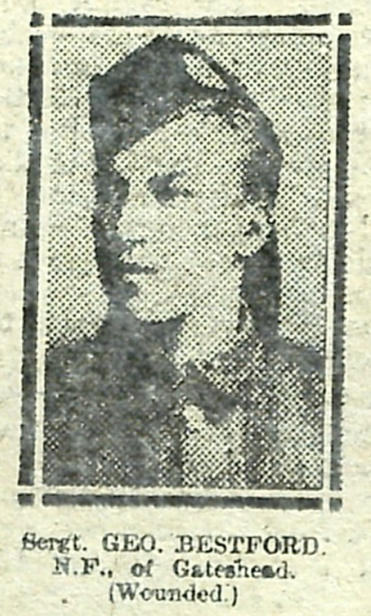
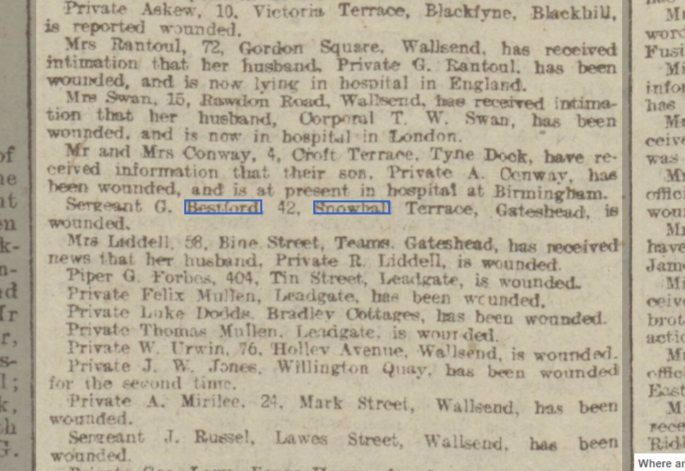
I have also attached a newspaper clipping relating to William Thomas Bestford - Newcastle Journal, Friday 28th July 1916. Along with a photo of William from the Illustrated Chronicle.

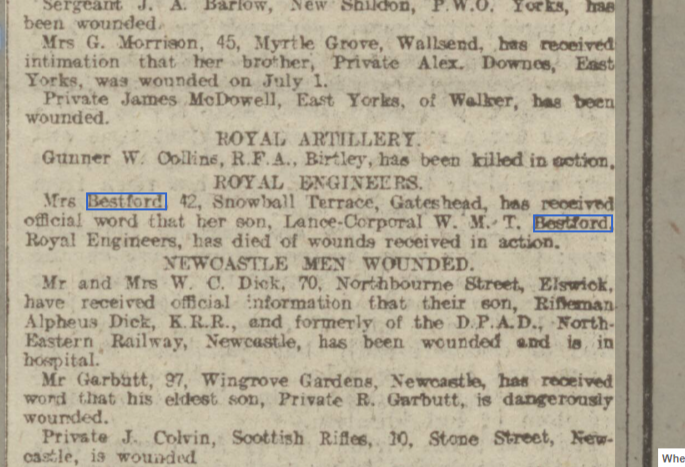
There is an Adam Bestford serving in the Royal Engineers, (n. 1248 & 459201) - possibly your man?.. I can' t find any evidence at the moment to link Adam to your Adam.
I have also found a William Bestford which I believe is their cousin. His father is William, brother of Thomas (father of the 6 boys). He served in the Northumberland Fusiliers (n. 19530). He was discharged 21st Feb 1918, residing at Bedlington Colliery. I have also attached a photo from the Illustrated Chronicle.
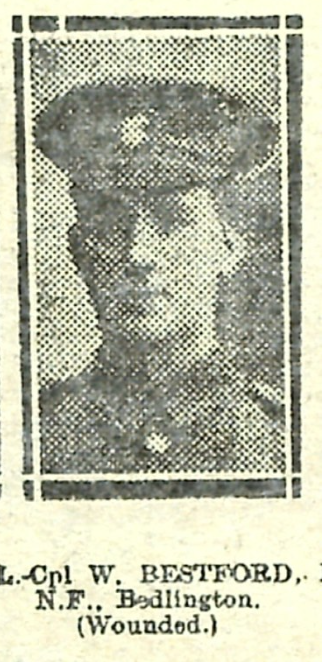
Many thanks,
James
-
Hello,
Perhaps an obvious/stupid question, but could anyone tell me what was "Red Row"? as if simply a colliery row in Bedlington Station, why is it built so far out from Bedlington Station... why did they chose that spot, to the North of Bedlington Station, east of Barrington and south of Stakeford and Bomarsund
On maps like the one attached, it is written in bold as if it is a village... is it a village? I don't think it had a colliery.
James
-
No, I don't have a Facebook - so I can't see the Barrington group
-
Thank you very much for posting it!
I don't really need anything on George, but I have a photo from the illustrated Chronicle they might not have/like to have!
George was one of seven pals from Barrington who enlisted together, all with consecutive service numbers, joining the 21st NF - George was the only one to be Killed.
Also Attached are his pension cards!
James
-
I am currently researching men of Barrington who died in both World Wars. It includes men who resided in Barrington, but also those born in Barrington
If anyone knows of any men I have missed, I'd love to know!
WW1: George Anderton; Henry Appleby; George Charlton; Robert A Charlon; John Cowans; Thomas H Cowen; James Dunbar; Aaron E Gardner; George E Gibbon; Joseph B Glendinning; George Grant; Mark F Green; Frank Foster; William Hardy; James Harle; James E Hartill; William Henderson; Thomas Hudspith; John W Hutchinson; George Jackson; Edward Johnson; Francis Johnson; John E Johnson; William Joisce; James W Jordan; Walter J Kelly; William Logan; William Montgomery; Alexander Orkney; George Paxton; John J Percy; Joseph Riddell; Joseph Ross; Henry R Routledge; Thomas R Routledge; Robert Sanderson; James Scurfield; Tom Smith; John Stoker; Arthur Thompson; Henry D Thompson; John W Turner; Luke Wanless; Joseph Weightman
WW2: John R Cook; John Hudspith; Leslie Joisce; William J Spencer
Cheers,
James
-
Thank you very much!
James
-
 1
1
-
-
On 23/09/2016 at 13:32, Alan Edgar (Eggy1948) said:
The reason I was searching for Double Row was the Barrington group were trying to establish how the rows, in Barrington, got their name. My 'fuzzy' memory came up with a thread that said I had been told (think it was by an uncle that married a lass from Barrington) that Double Row was the pit row that had an extra, 2 instead of 1, room down stairs. Searche on here just in case the explanation for the name was in one of HPW's stories.
Bedlington 'A' pit had North Row to the north of the pit and South Row to the South. Shop Row I assume had a shop but never new one in my time, 1953-60, passing and playing in that row when I went to Barrington school.
As you note 3g the naming of the Dr Pit - New South Row - doesn't appear to be logical. Do any of the old Dr Pit rows have a logic, that can be proved, to their names?
Shiney Row - Doctor Terrace - Telephone Row - New South Row - Cross Row & North Terrace.0
Barrington rows - the thoughts on the first rows built - those on the an 1859 :-
1) Chapel Row - was that because of the chapel?
2) Blacsmiths Row - was that where the Blacksmiths were housed?
3) School Row - next to the original school in the village?
4) Stone Row - ?
5) Double Row - was that because they had extra rooms, or just because it ran parallel with Chapel Row?
Then the next rows to be built, on a 1924 map :-
6) Victoria Row - after Queen Victoria?
7) Alexandra Row - after Princess Alexandra of Denmark ?
8) Freehold Row - ??
9) Railway Row - next to the railway?
10) Middle Row - it wasn't in the middle of Barrington but between Railway
and finally
11) Office Row - was that where the white & blue collar pit workers were housed, next to the pit managers house?
Hello,
Could you tell me how you found this particular map on the NLS website, as I would like to have a look at it, but I can't find it and struggle to use the website.
James

.thumb.png.77300168acdfb8bdfa93e7f166099855.png)
.thumb.png.391acd4176a4846a257c68a9ddf45fa0.png)


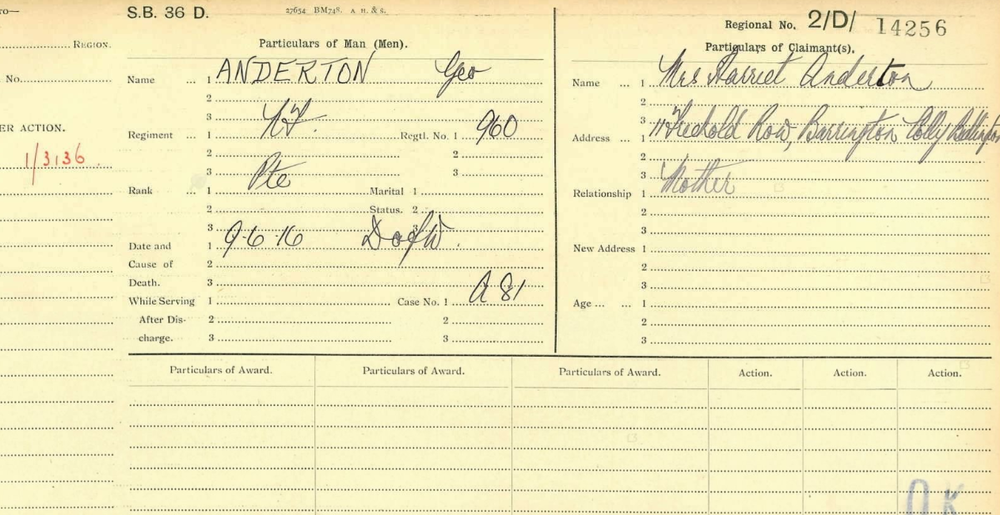
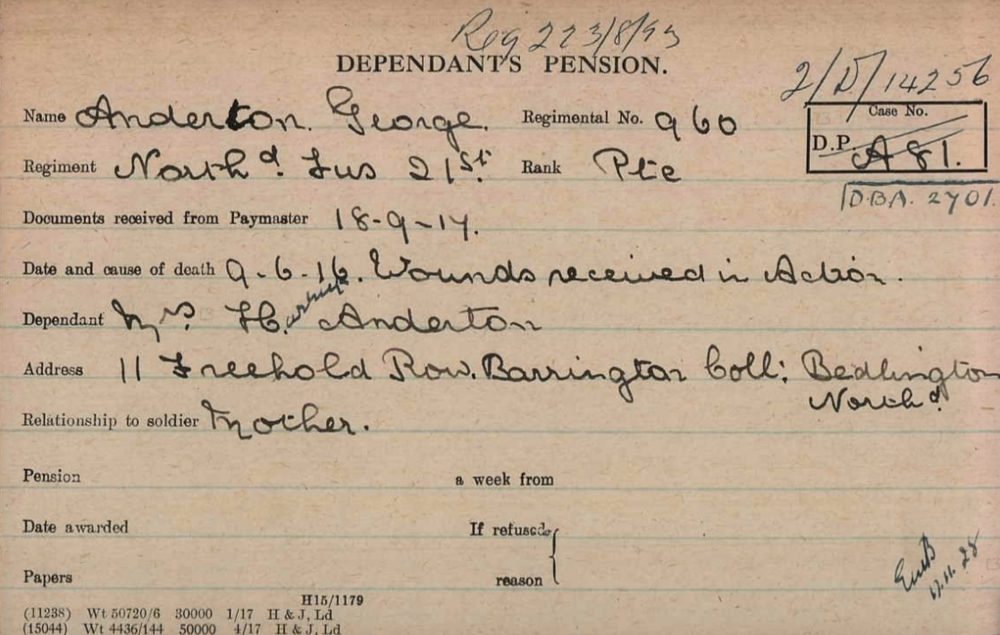
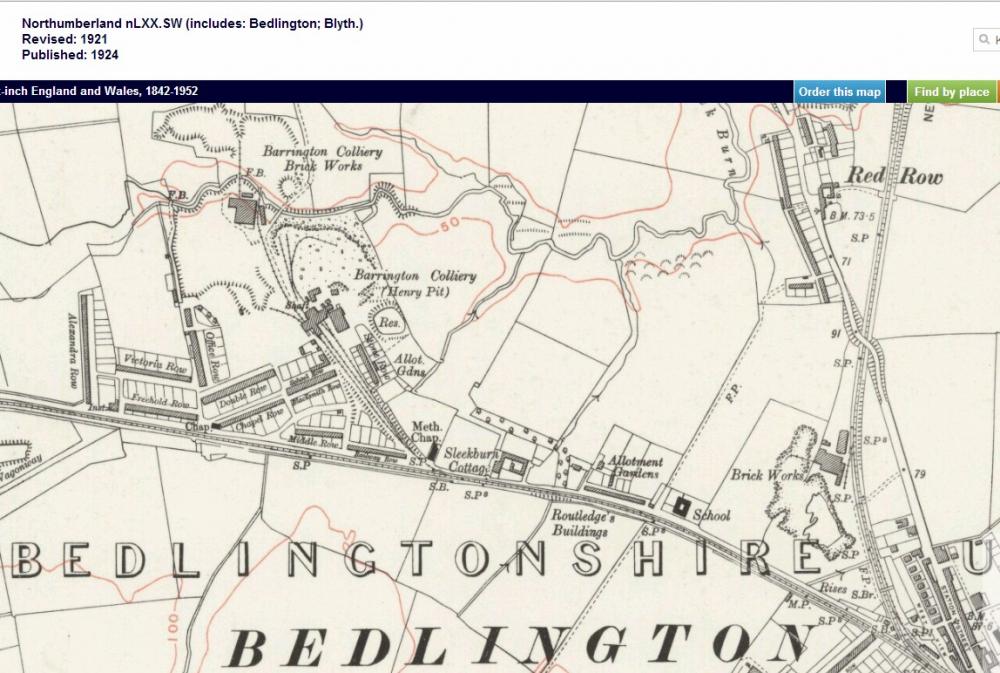
Red Row
in History Hollow
Posted
Ah thank you for making it clearer for me!
James